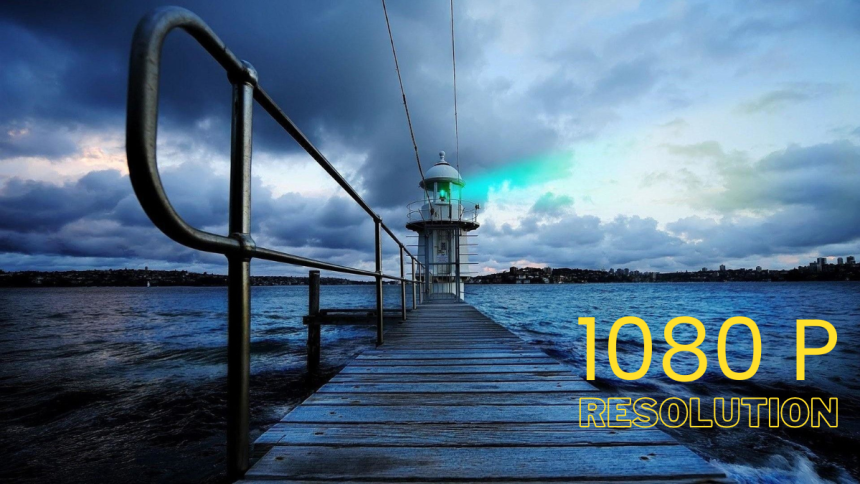You’ve probably seen it on your TV box. In your phone settings. In camera menus. That choice between 720p vs 1080p is everywhere, but here’s the problem—most people click and move on. No one explains what it actually means for your experience.
We’re going to fix that.
If you stream, record, game, or scroll through content, this post will show you what those extra pixels do. And whether they matter to you.
Let’s Talk Basics First: What Do 720p and 1080p Mean?
These aren’t marketing terms. They’re actual resolutions.
- 720p = 1280 (width) x 720 (height)
- 1080p = 1920 (width) x 1080 (height)
Both use rectangular pixels. Both are widescreen formats. But 1080p has more than twice the number of pixels as 720p. That’s a huge jump in clarity.
More pixels = more detail. Less blur. Sharper edges. Better visibility in shadows and highlights.
You’ll notice the difference when watching videos, especially on larger screens.
Why the Size of the Screen Changes Everything
Let’s be honest. Watching a 720p video on a tiny screen? It’s fine. You won’t see much difference.
But blow that video up on a 32″ monitor? Or a 50″ flat screen? You’ll definitely see the flaws.
- 720p gets pixelated.
- 1080p stays clean.
It’s like looking at a low-res photo zoomed all the way in. The quality can’t keep up. That’s why people upgrading TVs usually go 1080p minimum now. It’s the sweet spot between cost and quality.
Streaming Services Don’t Always Give You 1080p
Netflix, YouTube, Hulu—these platforms love to auto-adjust your resolution. That means even if you’ve got a 1080p screen, you may still be watching 720p without knowing it.
To check it:
- On YouTube, tap the gear icon → “Quality”
- On Netflix, go into playback settings in your account
- On Amazon Prime, check your video’s detail display
If your internet is slow, you’ll be served a downgraded version—usually 720p or worse.
Tip: Use an Ethernet cable instead of Wi-Fi. It keeps your quality consistent.
Does It Affect Mobile Video?
Yes, but only a little.
Phones have high-res screens now. Even budget models push over 1080p. But here’s the thing—your eye can’t always tell the difference on a small screen.
If you’re watching a video on a 6″ phone:
- 720p looks decent.
- 1080p looks better, especially for text or detailed shots.
- The real difference shows up in zoom, clarity, and color sharpness.
When you’re scrolling quickly, it doesn’t matter much, but for movies, games, or video calls, it matters.
Content Creation: Always Choose 1080p
Are you recording content? Filming product demos? Running tutorials? Use 1080p. No debate.
Why?
- Cropping is cleaner.
- Editing is smoother.
- Uploads look more professional.
Even platforms like TikTok and Instagram now prioritize higher resolution. 720p content gets downranked. It looks dated. Blurry. Especially on modern phones.
Pro tip: If you ever plan to repurpose the video—cut it, repost it, add text—always start in 1080p.
Gaming? Resolution Impacts Performance and Visuals
Gaming is where resolution gets really obvious. 720p vs 1080p? Big deal.
Here’s what happens at 720p:
- Graphics look fuzzy.
- Objects in the distance blur together.
- Text on-screen can be hard to read.
Now try the same game at 1080p:
- Crisper textures.
- Better color gradients.
- Cleaner UI and HUDs.
The difference hits hardest in RPGs and shooters. That detail matters when you’re exploring environments or spotting enemies at a distance.
Performance Tradeoff: Lower Res = Faster Load
To be fair, 720p still has some advantages.
Lower resolution demands less from your hardware. That means:
- Faster render times
- Less heat
- Smoother performance on older devices
If you’re gaming on a budget laptop or streaming over slow Wi-Fi, 720p may be the safe choice, but know what you’re trading off: clarity for speed.
Zoom Calls and Virtual Meetings
Video calls are everywhere now. Whether you’re taking interviews, hosting a class, or just chatting with family, your resolution affects how you show up.
Here’s what happens:
- At 720p, your face looks soft. Backgrounds blend.
- At 1080p, your features pop. You look more “real.”
Most webcams default to 720p. But more high-quality options (like Logitech Brio or newer MacBook cameras) go 1080p or even higher.
Pro tip: Clean your camera lens. A blurry lens at 1080p is still blurry.
Price Difference: Still a Factor?
Not really anymore.
Years ago, 1080p gear was pricey. Now it’s the standard. Most TVs, monitors, and smartphones are made for HD or higher. You won’t see much price difference unless you’re shopping for very old tech.
So don’t use cost as an excuse. You’re not saving much going with 720p anymore.
When 720p Still Makes Sense
Let’s be clear. There are times when 720p is still useful.
- You’re working with limited internet
- You’re using an older device
- You need to conserve battery
- You’re live streaming and need max stability
These are edge cases. In most everyday use, 1080p is the better experience.
TL;DR Breakdown
Let’s keep it simple.
| Feature | 720p | 1080p |
| Resolution | 1280×720 | 1920×1080 |
| Video Clarity | Decent | Sharp |
| Streaming Speed | Faster on slow internet | Needs solid Wi-Fi |
| File Size | Smaller | Larger |
| Best For | Small screens, older devices | Modern screens, content creation |
| Zoom/Calls | Basic quality | Professional look |
| Gaming | Blurry | Crisp and immersive |
Final Thought
So, does 720p still have a place? Yes, but it’s becoming more niche. More limited.
If you want cleaner visuals, better video, and a sharper experience, go 1080p. It’s not about chasing trends. It’s about giving your eyes what they deserve.
And if you’re still not sure what all of this means in real life, check out this helpful breakdown of 720p vs 1080p for real-world examples and visuals.
Once you experience true HD, there’s no going back.
Lynn Martelli is an editor at Readability. She received her MFA in Creative Writing from Antioch University and has worked as an editor for over 10 years. Lynn has edited a wide variety of books, including fiction, non-fiction, memoirs, and more. In her free time, Lynn enjoys reading, writing, and spending time with her family and friends.















